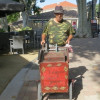Star Whites
late August 2010
2009 Northern Rhône whites were pretty successful, but I would highlight Crozes-Hermitage white 2009 as a real star this year - wines of consummate appeal, very drinkable, and fuller than in all recent years. Yum yum. Condrieu 2009 is also reviewed - a robust set of wines, no surprise, given the extreme heat in August. See 2009 Northern Rhônein the Left Hand column.
Crozes-Hermitage 2008 reds are less glorious, but have been reviewed under the 2008 Northern Rhône tab. Recent domaine visits include at Côte-Rôtie, Guigal, Gilles Barge and Stéphane Ogier. The Guigal top 2006 reds of Château d`Ampuis, Mouline, Turque and Landonne have all been tasted now they are in bottle. At Condrieu, André Perret`s range has been tasted during a July 2010 visit.
Name change: at the end of June, the Coteaux du Tricastin was no more. After all the bad publicity attached to the Tricastin name due to the Tricastin nuclear power plant leaks, growers were desparate to disassociate themselves from that unfortunate monikor. Appeals to be called Côtes du Rhône were rightly rejected, so the solution, a truly Frrrench solution, messieurs et madames, c`est de call eet somezing completely difficile for the silly foreigners. Yes - I bring you - trumpets, please - Grignan les Adhémar. Note the acute accent, you in the back row of the class.
From a heritage standpoint, Grignan is a fabulous fortified castle village, while La Garde Adhémar is a most attractive small hilltop village just visible from the A7 autoroute, where there are the ruins of a sixteenth century castle, and a Romanesque church. In my youth, there was an acclaimed Michelin one star small hotel-restaurant there. Both sides of this equation have a first-class historical pedigree, donc (thus). But - selling the wine around the world, having people remember it, pronounce it without risking feeling silly . . ? Ah well.
Hot and Dry
late August 2010
August has been hot and dry, but the daytime heat running into the low 30s°C has been offset by cool nights which allow the vines to switch off and preserve acidity. In the South there has been some coulure on the Grenache - flowers not converting into fruit, just as I have experienced with my Painted Lady and Scarlet Emperor Runner Beans in Sussex, on the English south coast. Harvest dates look like being around 10 days behind 2009, when the extreme heat in late August made things happen very quickly.
Throughout this summer, the warm day, cool night pattern has been helpful, and bodes well for freshness in the wines. Earlier in August, temperatures moved back towards 25-28°C, cool enough for Christian Vache of Domaine de la Monardière at Vacqueyras to lunch indoors rather than outside under the shade. The nights in both Northern and Southern Rhône have been helpfully fresh - in the South, the mornings start at about 16-18°C, so the vines rest at night, and acidity levels are still good. In the Northern Rhône, around Condrieu and Saint-Joseph, the days commence at 14-17°C.
The vineyards are in good shape, the South being marked by a lot of healthy Mistral wind. However, the young vines have felt the effect of very little rain - after around 30mm (1.2 inches) in late June, there was just 4mm in July around Vacqueyras and Gigondas, with temperatures well into the mid-30s°C. The Grenache was just starting to turn colour - the véraison - in the first week of August. The old vines are in good shape, and reserves of water from the spring rains have played an important role this year in defending the plants from the drought.
The Northern Rhône experienced rain on 2 August, but it was variable across the region: around 10mm (0.4 inch) at Ampuis, home of Côte-Rôtie, nearer 45mm (1.8 inches) at Chavanay, home of Condrieu and Saint-Joseph. The Viognier is reported as having had a very good flowering this year. In this sector, the full hillside vines have fared better with the dry weather than those growing in the plateau areas, and richer soils. Young vines are also suffering from the July heat and drought.
The picture building up is of a harvest around 2 weeks later than 2009`s extremely precocious date - "this will make the vinification more interesting due to probably cooler weather," Christian Vache remarked. In the South, 10-15 September as a start date, in the North around 20 September as a start date.
